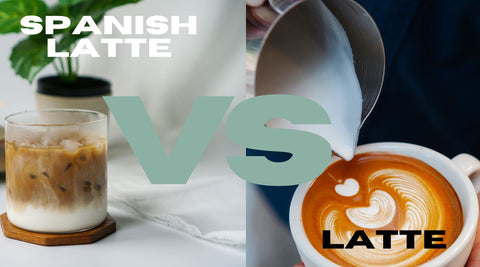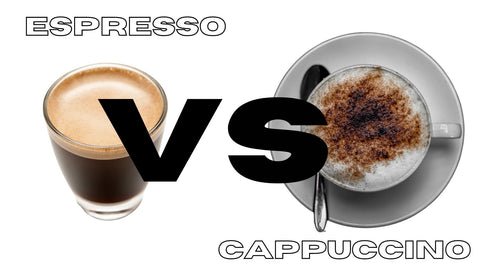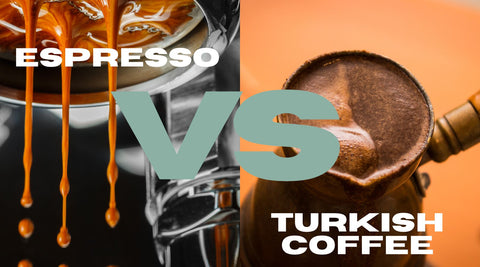Coffee is a popular beverage in many countries, and coffee culture tends to differ in each country. That is particularly noticeable when you look at the differences between European and American coffee lovers. While the basics are the same, you’ll find some noticeable differences. Each region tends to put a unique twist on some popular coffee drinks.
Among the many variations, Spanish Latte and Latte are two popular choices that often leave coffee enthusiasts wondering what the actual differences are. Is there really anything different between an ordinary Latte and a Spanish Latte?
In this article, we'll look at the distinct characteristics of both milky drinks to help you understand what sets them apart and how to make the Spanish version yourself.
Quick Answer
If you don’t care about the details, here’s a quick answer to the question: What is the difference between a Spanish one and a regular Latte?
The primary differences are the milk ratio, sweetness, and preparation method. The Spanish version of a Latte has a touch of Spanish influence (surprise!). It uses sweetened condensed milk in addition to normal milk for a unique flavor profile but has a lower milk-to-espresso ratio than a classic Latte.
Curious to learn more and get your hands on a Spanish Latte recipe? Then let’s dive into the more detailed answer.
What Is A Spanish Latte?
A Spanish Latte is a sweet twist on the classic Latte. It consists of espresso, scalded milk, and sweetened condensed milk.
Thanks to condensed milk, this coffee beverage has a creamier and slightly sweeter taste than the traditional Latte. The drink originates from Spain and has recently gained popularity in other parts of the world. It is a delicious alternative for those with a sweet tooth.
You can add some additional sweeter or flavored syrups if you want it even sweeter, but usually, nothing else is added to a Spanish Latte.
What Is A Latte?
People become confused when the names of coffee beverages are similar (a good example is a Latte Macchiato vs. a normal Macchiato), and it’s no different with a Spanish Latte vs. a Latte. Before we compare the two drinks, let’s look at what a “normal” Latte is.
A Latte, short for Caffè Latte, translates to "milk coffee" (from Italian). It is a coffee drink made with espresso and steamed milk, typically topped with a thin layer of frothed milk. Lattes have a balanced flavor and are popular because they combine the robustness of espresso with the creamy texture of milk. People love adding syrups, like caramel, to their Latte.
Key Differences Between These Milky Drinks
Now that you know the basics, it’s time to examine the differences between a Spanish Latte and a Latte.
The differences are the milk ratio, the sweetness, and the preparation method (a Spanish Latte is a little more involved than an ordinary Latte - but it’s not rocket science).
1. Milk Ratio
The milk ratio is the most noticeable difference between a Spanish Latte and a regular Latte. Now, you may think that there's more milk in a Spanish Latte because it uses two different types of milk: ordinary milk and condensed milk. That's not the case, though.
A Spanish Latte tends to have a lower proportion of milk compared to a classic Latte.
A classic latte mixes one part espresso with two parts steamed milk (1:2), while the ratio for a Spanish Latte is 1:1.
2. Sweetness
In addition to the quite nice texture, lovers of sweet coffee beverages will also appreciate the second key difference.
Traditional Lattes are not inherently sweet. They only become sweet when people add sugar, sweeteners, or syrups.
In contrast, a Spanish Latte is always on the sweeter side because sweetened condensed milk is one of its three ingredients. This makes it a perfect choice for those who prefer their coffee to be sweeter.
3. Preparation
While the preparation of both drinks has some steps that are similar (like pulling 1-2 shots of espresso), there are also differences that contribute to why a Spanish Latte tastes and feels different from a traditional Latte.
A traditional Latte is made by carefully pouring steamed milk over a shot of espresso (or two shots if you want a stronger version). It’s a fairly simple process.
A Spanish Latte, on the other hand, involves adding sweetened condensed milk. The condensed milk is often mixed with the espresso before adding scalded (not steamed or boiled) milk.
If this sounds a little confusing, let's have a look at how this drink is made so you can try it at home!
How To Make A Spanish Latte Recipe
If you quite like the idea of this sweet espresso (or strong coffee) based drink and want to try making one at home, here's a simple Spanish Latte recipe.
Necessary Equipment:
-
Espresso machine, you can get away with brewing some strong coffee with what’s available to you.
-
Small saucepan (for heating the milk)
-
Milk frother or whisk
-
Your favourite mug
Ingredients:
-
Ground coffee beans to make 1-2 shots of espresso (or strong coffee as an alternative if you have no option to make espresso)
-
3 ounces fresh milk (almond milk or oat milk also works)
-
1.5 teaspoons sweetened condensed milk (or more if you like it sweeter)
-
Optional (for decoration): Cinnamon, cocoa, or espresso powder
Note: If you are unsure about which coffee beans to use for this Spanish latte recipe, check further below, where we introduce three great options that work well.
Instructions:
-
Pull 1-2 shots of espresso (or brew strong coffee in a coffee machine or French Press).
-
Mix the sweetened condensed milk with the espresso until well combined.
-
Heat the fresh milk in the saucepan, but do not let it boil. It’s only supposed to be “scalded”.
-
You can either use the scalded milk as is or use a whisk or milk frother to froth the scalded milk.
-
Pour the scalded milk over the espresso and condensed milk mixture.
-
Stir gently.
-
Optionally, top with a sprinkle of cocoa, espresso powder, or cinnamon.
Can I Serve My Spanish Latte Iced?
Yes, making the above as an iced version is no problem, and it's fairly simple. Just follow steps 1 and 2 from the above recipe, let the mixture cool down, then add cold milk and some ice cubes: And you have an Iced Spanish latte. If you just want a cooler drink, you can omit the ice cubes.
Iced Spanish Latte is a lovely, mildly sweet beverage that’s perfect for hot summer days or when you simply don’t feel like having a hot coffee. Top it with whipped cream and cocoa powder for some extra indulgence.
Nutrition Comparison
Understanding the differences in nutritional content between a Spanish version and a classic Latte can be important for people on diets or who simply want to know what they’re putting into their bodies. So, let’s look at the differences in nutrition.
This comparison is based on a 12 oz serving without added sugar or sweetener and made with ordinary milk (if you use plant-based alternatives, e.g. oat milk or almond milk, or half-fat milk, the nutritional info for both drinks will become slightly healthier).
Nutrition Overview
-
Calories: A latte contains 180-200 calories, and a hot Spanish Latte has much more (250-300 calories).
-
Fat: A normal Latte contains 5-6g of fat (of which 3-4g are saturated and 1-2g saturated fat). The Spanish one has 8-10g (5-6g saturated, 2-3g unsaturated)
-
Carbohydrates: There is a huge difference here, thanks to the condensed milk. A normal Latte contains 12-14g of carbs (of which 10-12g is sugar). The Spanish one contains a whopping 25-30g (of which 20-25g is sugar).
-
Protein: Latte vs Spanish Latte comes in at 8-10g vs 9-11g.
-
Calcium: A normal Latte contributes 300-350mg to your calcium intake, while a traditional Spanish Latte offers 400-450mg.
-
Vitamin D: A traditional Latte has 100 IU, and a Spanish one has 150 IU.
Caffeine Content
Of course, no discussion about two different types of coffee is complete without talking about caffeine. But you may already have guessed the answer: Both drinks contain espresso as their base. Both can be made with one or two shots of espresso, so the caffeine content per serving is relatively similar unless you compare a 1 shot Latte vs a 2 shot Spanish Latte.
There is, however, a potential difference in how you perceive the strength of each drink. The sweetness and creaminess of the Spanish Latte may make you think that the Spanish Latte isn’t as strong as it actually is.
Is A Spanish Latte The Same As Vietnamese Coffee?
Spanish Latte and Vietnamese Coffee are both a unique blend of coffee and condensed milk. While they share some similarities, they are two different drinks that are prepared in different ways and taste different.
Vietnamese coffee typically uses a strong, dark roast coffee, often brewed with a traditional drip filter instead of an espresso shot. This is then mixed with sweetened condensed milk.
The result is a bold and intensely flavored drink that differs from a Spanish Latte's smoother and milder taste.
What Are The Best Coffee Beans To Use To Make A Spanish Latte?
Choosing the right coffee beans is the first step to making a great Spanish Latte. If the base espresso coffee doesn’t taste nice, the resulting Latte or Spanish Latte also won’t be particularly outstanding. You should choose a medium to dark roast, as these impart a robust flavor that can stand up to the sweetness of the condensed milk. You’ll get a particularly nice result if you choose beans with hints of chocolate, caramel, or nutty undertones.
Why not try our Sugarloaf Espresso Roast. These ethically sourced beans come from farms in Guatemala and Brazil and are roasted to espresso perfection (which is what you want for a Spanish Latte). The hints of vanilla, hot chocolate, and walnut are a wonderful combination that works beautifully with the sweetness of condensed milk in a Spanish Latte. Unlike some other beans, these are also very safe to use in an espresso coffee machine!
Now To Drink It
You have now learned a lot about Latte vs. Spanish Latte and that neither is Vietnamese coffee. You probably have learned more than you wanted to, but that’s not ever a bad thing when it comes to coffee, right?
To summarize: The distinction between a Spanish Latte and a Latte lies in:
-
The espresso to milk ratio (Latte is 1:2 and Spanish Latte is 1:1),
-
Sweetness (Spanish Latte is inherently sweeter because of the use of condensed milk)
-
The preparation method (The Latte is fairly easy and made with steamed milk, while the Spanish Latte takes a little more time, is made with scalded milk, and can also easily be turned into an iced version).
While a Latte offers a classic and balanced experience, a Spanish Latte adds a touch of sweetness and creaminess. It's a good option for coffee lovers with a sweet tooth who don't want to opt for sweet syrups in their Latte.
This sweet indulgence comes with a bit of a price, though: Nutritionally, an ordinary Latte is healthier as it contains less fat and less sugar. If you don’t drink too many Spanish Lattes daily and lead an otherwise healthy lifestyle, that’s nothing to worry about.



